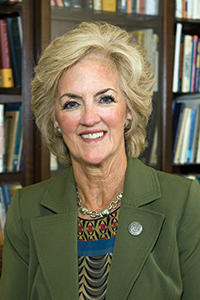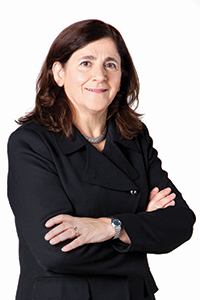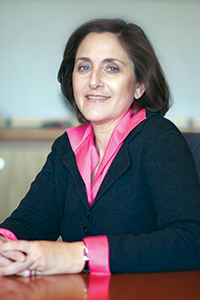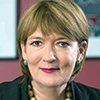This is supposed to be the Year of the Horse, according to the Chinese calendar. Yet it might be remembered with a different kick. From sound bites on the news from women CEOs at such old-line companies as General Motors to Hillary Clinton’s position as the frontrunner in the polls for the Democratic nomination for the presidency, 2014 is shaping up as the Year of the Woman.
While women remain in the minority as leaders at America’s largest companies, their numbers are rising. In 2014, 24, or 4.8 percent of America’s Fortune 500 CEOs are women, up from 20 in 2013 and more than at any time since Fortune magazine began tracking executives’ gender in 1998.
Progress is evident in other areas as well. Economist Janet Yellen made headlines earlier this year when she became the first woman chair of the Federal Reserve Board of Governors, which sets the country’s monetary policy.
In Virginia, the story is much the same, with women heading major business initiatives. Among Virginia’s 22 Fortune 500 firms, two are led by women. One of them, General Dynamics’ Phebe N. Novakovic, was the highest paid public company CEO in Virginia last year, with $18.7 million in total compensation. (See “Paid to perform“)
The other Fortune 500 CEO, Gracia C. Martore at McLean-based Gannett Inc., will assume a new challenge when the corporation splits into two publicly traded entities. One company will include Gannett’s newspapers, and the other, which Martore will lead, will house its digital and broadcast properties.
In Newport News, Barbara A. Niland played a key role in the 2011 spinoff of Huntington Ingalls Industries (HII), the former giant shipbuilding arm of Fairfax County-based Northrop Grumman Corp. After creating HII’s corporate financial team from scratch, Niland became CFO of what is now an independent Fortune 500 company.
 Meanwhile in Richmond, Gail W. Johnson serves as a successful model for women entrepreneurs. Twenty-five years after starting Rainbow Station Inc., she is taking her preschool franchise model overseas. The company has opened two of what are expected to be 110 schools in China and is expanding into Indonesia as well.
Meanwhile in Richmond, Gail W. Johnson serves as a successful model for women entrepreneurs. Twenty-five years after starting Rainbow Station Inc., she is taking her preschool franchise model overseas. The company has opened two of what are expected to be 110 schools in China and is expanding into Indonesia as well.
Johnson, who began her career as a pediatric nurse, can remember when women had few career choices. “I have seen a lot of change. Maybe we aren’t where we need to be in 2014, but we in are in much better place than we have been in the past.”
As proof, Johnson shares this anecdote. “Just a few years back, I walked into a dealership with the intention of buying four new vans for Rainbow Station. I was totally ignored as if I wasn’t even there,” she recalls, “and I believe I was not taken seriously because I am a woman.”
When Johnson went to leave, a sales associate finally approached her and learned that she was ready to purchase vehicles. “Needless to say they tried to relentlessly to get me back inside. I refused to do business with them from that day on. But today this would never happen.”
Johnson, Niland and Martore were among five women executives who agreed to participate in an email survey conducted by Virginia Business about some of the major business challenges facing executives today. The other women are Nancy H. Agee, president and CEO of Carilion Clinic, a major regional health system based in Roanoke, and Nancy Taylor, president and CEO of Tredegar Corp., a plastics film and aluminum extrusions company in Richmond. (See separate story on Taylor).
Besides challenges, the women discussed how their companies recruit top talent and weighed in on work/life balance, compensation and what motivates them as leaders.
Gender equality
 When it comes to gender equality, Gannett takes pride in its woman-led management team. In 2013 the Women’s Forum of New York named Gannett as one of 40 Fortune 500 companies to have 30 percent or more female membership on its board of directors. “It’s crucial for diversity to be a core value,” says Martore. “Our top executive positions are led by women who serve in the chairman, CEO, CFO and CMO roles. Diversity is one of the key performance indicators by which senior management is evaluated.”
When it comes to gender equality, Gannett takes pride in its woman-led management team. In 2013 the Women’s Forum of New York named Gannett as one of 40 Fortune 500 companies to have 30 percent or more female membership on its board of directors. “It’s crucial for diversity to be a core value,” says Martore. “Our top executive positions are led by women who serve in the chairman, CEO, CFO and CMO roles. Diversity is one of the key performance indicators by which senior management is evaluated.”
While more women are moving into the C suite, the fact that Sheryl Sandberg’s recent TEDtalk and book, “Lean In,” resonated with so many women is “pretty hard  evidence that we still don’t have gender equality,” says Taylor. In the book, Facebook’s chief operating officer looks at why women’s progress in achieving leadership roles has stalled, even though there are more women in the pipeline, and 50 percent of the nation’s college graduates are women. She talks about how women unintentionally hold themselves back in their careers by not “leaning in” and aggressively pursuing their career goals with confidence, and she offers tips on how to do this. “What it takes to get there will be different by industry, company and individual, but there are a number of common challenges,” says Taylor.
evidence that we still don’t have gender equality,” says Taylor. In the book, Facebook’s chief operating officer looks at why women’s progress in achieving leadership roles has stalled, even though there are more women in the pipeline, and 50 percent of the nation’s college graduates are women. She talks about how women unintentionally hold themselves back in their careers by not “leaning in” and aggressively pursuing their career goals with confidence, and she offers tips on how to do this. “What it takes to get there will be different by industry, company and individual, but there are a number of common challenges,” says Taylor.
 On the issue of pay equity, some women noted that compensation for women executives is getting better. “When women first began achieving executive positions, their pay was not equitable, but that curve is flattening and will continue to do so,” says Agee. “The more executive compensation reflects accountability for performance, the less gender is a factor in the equation.”
On the issue of pay equity, some women noted that compensation for women executives is getting better. “When women first began achieving executive positions, their pay was not equitable, but that curve is flattening and will continue to do so,” says Agee. “The more executive compensation reflects accountability for performance, the less gender is a factor in the equation.”
In Virginia, full-time working women earned 76.9 percent of the pay of their male counterparts, which ranks the Old Dominion 32nd among the states, according to a recent analysis by the Institute for Women’s Policy Research. The national average was 78.6 percent.
In the Virginia Business email poll, women cited a range of business challenges, from maintaining a competitive advantage to responding to the needs of customers and consumers. Often the challenges of running a business are industry specific. For instance, at HII, Niland worries about having one primary customer, the U.S. Navy, which commissions the nuclear-powered ships her company builds. “Add to that the specter of sequestration, and the result is a significant challenge to resource planning, including employment levels (due to potential and unknown workload fluctuations) and capital allocations.”
Agee’s organization has nine hospitals, employs 600 physicians and operates nearly 200 practice sites. She says the key to leading an organization of this size and complexity is “a culture of collaboration, partnerships and relationships.”
Attracting top talent
Recruiting top talent is crucial. The women said they focus on hiring the best and brightest. “We are always looking for the ‘A’ performers — those exceptional individuals who raise the bar,” says Martore.
“The key is to create a culture where the best employees want to work and aren’t afraid to take bold steps.”
Overall, creating a work environment that offers opportunities for growth along with competitive benefits and compensation helps recruit and retain top talent. Niland says HII offers wellness programs and affordable health care as well as significant workforce development opportunities, including two apprentice schools. “We are focused on our employees’ well-being.”
To find skilled employees, Taylor says, her company uses an outside recruiting firm, while Johnson’s company recruits on college campuses and has an intern program.
Maintaining a work/life balance can be a challenge, the women said, no matter the industry, largely because of globalization. “Today with globalization, technology and particularly communication devices, we are in a 24/7, no work-hour boundary environment, and you have to manage that in a way that meets both the business requirements and your personal needs,” says Niland.
Some of the women said their companies are responding with practices such as flexible scheduling and wellness initiatives in addition to encouraging employees to use vacation time. “Unique to our business, you also have the option to bring your child to work,” Johnson says. “It can be really nice to be able to just pop into the other room and check on your child a couple of times throughout the day.”
Success is built on personal motivation, and several of the women say they are motivated not only by the impact their company has on the community but also the investment they have in their colleagues.
“Just the other day I was watching a young leader in our organization, someone I have known for several years, and I was so impressed with the ease with which he handled himself, his confidence, communication skills and his ability to work with a team. I told him so, and he said, ‘You taught me how to do it.’ That is what motivates me,” says Agee.
Building a company that is strong and well positioned for the future motivates Taylor and Martore. “The idea of shaping a business that creates value today and into the future for shareholders, for customers, for employees,” says Taylor. “ … I can’t emphasize enough how seriously I take that responsibility. It is my driver.”
Martore also noted the many constituencies that CEOs strive to serve. “My goal is to serve them all well by leading well.”


 Meanwhile in Richmond, Gail W. Johnson serves as a successful model for women entrepreneurs. Twenty-five years after starting Rainbow Station Inc., she is taking her preschool franchise model overseas. The company has opened two of what are expected to be 110 schools in China and is expanding into Indonesia as well.
Meanwhile in Richmond, Gail W. Johnson serves as a successful model for women entrepreneurs. Twenty-five years after starting Rainbow Station Inc., she is taking her preschool franchise model overseas. The company has opened two of what are expected to be 110 schools in China and is expanding into Indonesia as well. When it comes to gender equality, Gannett takes pride in its woman-led management team. In 2013 the Women’s Forum of New York named Gannett as one of 40 Fortune 500 companies to have 30 percent or more female membership on its board of directors. “It’s crucial for diversity to be a core value,” says Martore. “Our top executive positions are led by women who serve in the chairman, CEO, CFO and CMO roles. Diversity is one of the key performance indicators by which senior management is evaluated.”
When it comes to gender equality, Gannett takes pride in its woman-led management team. In 2013 the Women’s Forum of New York named Gannett as one of 40 Fortune 500 companies to have 30 percent or more female membership on its board of directors. “It’s crucial for diversity to be a core value,” says Martore. “Our top executive positions are led by women who serve in the chairman, CEO, CFO and CMO roles. Diversity is one of the key performance indicators by which senior management is evaluated.” evidence that we still don’t have gender equality,” says Taylor. In the book, Facebook’s chief operating officer looks at why women’s progress in achieving leadership roles has stalled, even though there are more women in the pipeline, and 50 percent of the nation’s college graduates are women. She talks about how women unintentionally hold themselves back in their careers by not “leaning in” and aggressively pursuing their career goals with confidence, and she offers tips on how to do this. “What it takes to get there will be different by industry, company and individual, but there are a number of common challenges,” says Taylor.
evidence that we still don’t have gender equality,” says Taylor. In the book, Facebook’s chief operating officer looks at why women’s progress in achieving leadership roles has stalled, even though there are more women in the pipeline, and 50 percent of the nation’s college graduates are women. She talks about how women unintentionally hold themselves back in their careers by not “leaning in” and aggressively pursuing their career goals with confidence, and she offers tips on how to do this. “What it takes to get there will be different by industry, company and individual, but there are a number of common challenges,” says Taylor. On the issue of pay equity, some women noted that compensation for women executives is getting better. “When women first began achieving executive positions, their pay was not equitable, but that curve is flattening and will continue to do so,” says Agee. “The more executive compensation reflects accountability for performance, the less gender is a factor in the equation.”
On the issue of pay equity, some women noted that compensation for women executives is getting better. “When women first began achieving executive positions, their pay was not equitable, but that curve is flattening and will continue to do so,” says Agee. “The more executive compensation reflects accountability for performance, the less gender is a factor in the equation.”